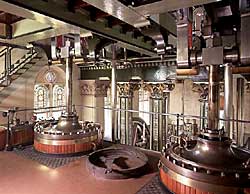
 |
View of the tops of the two cylinders and connecting links to the beams (photograph © Martine Hamilton Knight). |
Structural
Papplewick Pumping Station has a handsome assemblage of late nineteenth century structures and one very new reproduction. The site is approached by a walled perimeter leading to a gated entrance. Entry for visitors is by the Superintendent’s house, a substantial Victorian villa. The main building comprises of the Boiler House and the Beam Engine House. At the rear is the newly constructed Coal Shed. The original building used to be served by horse and cart in the days before modern tipper lorries. Other buildings include a smithy, various workshops and staff accommodation. Two other modern buildings house the Linby Winding Engine (another steam powered engine shed at the former nearby Linby Colliery) and a supplementary boiler house (needed to provide extra steam) with adjacent amenity block (refreshments) and a dedicated educational discovery room. Papplewick Pumping Station has a special relationship with the Linby cum Papplewick school and special programmes have been devised to support the National Curriculum.
The grounds have been restored and replanted and the central feature is the Cooling Pond, newly restocked with carp and other fish. To the west of the site lies the former brick built reservoir taken out of service early in the last century, following subsidence. Work is on-going to make this spectacular structure accessible to the public once more.
The site is a scheduled Ancient Monument and the key buildings are listed Grade II.